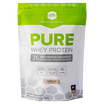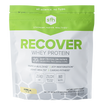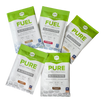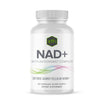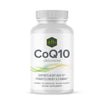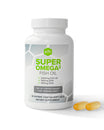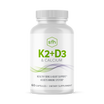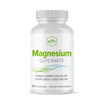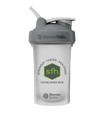Vitamin D & the 37th Parallel
If you’re living in the northern half of the United States, you’re going to want to pay attention to this one!
Aptly nicknamed “the sunshine vitamin,” Vitamin D is the only vitamin that your body can make simply by getting adequate exposure to UV rays from sunlight. But as the seasons change and the sun's presence in the sky gets shorter, your chance of getting enough sunlight exposure diminishes.
And here’s the kicker: if you’re living north of the 37th parallel, your risk of Vitamin D insufficiency increases even more.
Here’s what you need to know about the 37th parallel, how it can affect your Vitamin D status, and what you can do about it.
What is the 37th Parallel?
The “37th parallel” refers to a latitude: more specifically, 37 degrees north of the equator.
Because the northern parts of America (as defined by that 37-degree latitude line) get less sunlight than the south, some scientists believe that living above the 37th parallel can increase your risk of developing a Vitamin D insufficiency, especially in the autumn and winter months in which the sun is out less to begin with. This also applies to areas that are below 37 degrees south of the equator.

How many people aren’t getting enough Vitamin D?
Vitamin D deficiency is an incredibly prevalent nutrition problem throughout the world – in fact, some cite it as the most common medical condition worldwide! It’s estimated that between 14-59% of the adult population have a Vitamin D deficiency globally. In the United States, data collected via the National Health and Nutrition Examination Survey suggests that almost 40% of adults over 20 years of age may be Vitamin D deficient.
So why are Vitamin D deficiencies so common, when your body can make it on its own? It could be due to a variety of factors. Besides living north of the 37th parallel, you might be at a higher risk for Vitamin D insufficiency if:
- you get less sun exposure in general (for example: if you spend a good amount of time indoors)
- you have more melanin in your skin, which absorbs much of the UV rays needed to initiate Vitamin D synthesis
All these factors can limit your body’s ability to make or use Vitamin D, thus contributing to the global Vitamin D insufficiency problem.
What are the effects of insufficient Vitamin D intake?
- Weak, brittle bones - Vitamin D is necessary for absorbing calcium, the mineral that is paramount of healthy bone structure. So if you are not getting enough Vitamin D, it can lead to serious issues that compromise your bone health including rickets, osteoporosis, and osteomalacia, or a softening of the bones.
- Mental health - In addition to the physical effects that low Vitamin D can have on your body, there’s also evidence that it can interfere with your mental health as well. Insufficient Vitamin D levels have sometimes been associated with mood disorders like seasonal affective disorder (SAD) and depression.
- Weakened immune system - Vitamin D also plays a variety of roles in your immune system, and some studies have found that a deficiency can increase one’s susceptibility to infections.
Can you get enough Vitamin D from food? Should you supplement with Vitamin D?
The good news for those living above the 37th parallel: you don’t have to rely only on sunshine alone for your Vitamin D fix. You can also get Vitamin D from foods and supplements!
Different variations of Vitamin D
Vitamin D can come in two different forms:
- Ergocalciferol, aka Vitamin D2, which comes mostly from plant-based sources
- Cholecalciferol, aka Vitamin D3, which comes from animal-based sources
Even though these two forms of Vitamin D vary slightly in chemical structure, they can both help raise your Vitamin D levels. However, there’s evidence to suggest that the D3 version is better at improving Vitamin D status when compared to the D2 form.
Vitamin D in foods compared to a supplement
Unfortunately, one of the reasons that an adequate Vitamin D intake is so hard to meet is that very few foods naturally contain it.
Vitamin D is naturally present in some fatty fish, as well as in eggs, mushrooms, and a couple of other dietary staples, but in general it’s fairly hard to find in foods. This means that many foods are actually fortified with Vitamin D -- in other words, Vitamin D is added to foods after the fact so that people can get closer to their recommended Vitamin D intakes. Even still, food alone may not be enough to get enough Vitamin D, especially for those above the 37th parallel.
So unless you’re eating huge amounts of fish and other foods containing Vitamin D, one of the best ways to ensure that you’re getting enough Vitamin D for optimum health is to take a supplement like SFH’s Omega-3 Fish Oil + Vitamin D3, which contains much more Vitamin D than many people would get from food alone.
| Food Sources of Vitamin D | Vitamin D Amount (IU) |
|---|---|
| Salmon (3.5 oz) | 360 |
| Mackerel (3.5 oz) | 345 |
| Tuna, canned (3.5 oz) | 200 |
| Orange juice, fortified (8 oz) | 100 |
| Breakfast Cereals, fortified (1 serving) | 40-100 |
| SFH Omega-3 Fish Oil + Vitamin D (1 serving) | 1000 |
The bottom line
Vitamin D deficiencies are shockingly common, especially as you move further away from the equator. The problem only gets worse during the colder, darker winter months.
Therefor, a Vitamin D supplement can make a huge difference for your overall nutrition status! SFH’s Omega-3 Fish Oil + Vitamin D comes with the highest concentration of essential omega-3s DHA + EPA plus a whopping 1000 IUs of Vitamin D per serving. Adding it to your daily routine is a great all-in-one solution for meeting some of your most important nutrition needs, during the winter and beyond.
Meet the Author

Erica Digap is a science-minded copywriter specializing in evidence-based nutrition science, fitness, and health content. After receiving her Bachelor of Science in Clinical Nutrition from the University of California, Davis, and working as a consultant and director in the corporate diet industry for many years, she decided to set forth and use her experience and expertise to inspire readers to make lasting, healthy lifestyle changes – one nutritious meal and workout at a time.
*These statements have not been evaluated by the Food and Drug Administration. These products are not intended to diagnose, treat, cure or prevent any disease.
Sources:
- Time for more vitamin D. Harvard Health. (2008, September 1). Retrieved October 18, 2022, from https://www.health.harvard.edu/staying-healthy/time-for-more-vitamin-d
- Hovsepian S, Amini M, Aminorroaya A, Amini P, Iraj B. Prevalence of vitamin D deficiency among adult population of Isfahan City, Iran. J Health Popul Nutr. 2011 Apr;29(2):149-55. doi: 10.3329/jhpn.v29i2.7857. PMID: 21608424; PMCID: PMC3126987.
- Christodoulou S, Goula T, Ververidis A, Drosos G. Vitamin D and bone disease. Biomed Res Int. 2013;2013:396541. doi: 10.1155/2013/396541. Epub 2012 Dec 27. PMID: 23509720; PMCID: PMC3591184.
- Penckofer S, Kouba J, Byrn M, Estwing Ferrans C. Vitamin D and depression: where is all the sunshine? Issues Ment Health Nurs. 2010 Jun;31(6):385-93. doi: 10.3109/01612840903437657. PMID: 20450340; PMCID: PMC2908269.
- Aranow C. Vitamin D and the immune system. J Investig Med. 2011 Aug;59(6):881-6. doi: 10.2310/JIM.0b013e31821b8755. PMID: 21527855; PMCID: PMC3166406.
- Tripkovic L, Lambert H, Hart K, Smith CP, Bucca G, Penson S, Chope G, Hyppönen E, Berry J, Vieth R, Lanham-New S. Comparison of vitamin D2 and vitamin D3 supplementation in raising serum 25-hydroxyvitamin D status: a systematic review and meta-analysis. Am J Clin Nutr. 2012 Jun;95(6):1357-64. doi: 10.3945/ajcn.111.031070. Epub 2012 May 2. PMID: 22552031; PMCID: PMC3349454.



